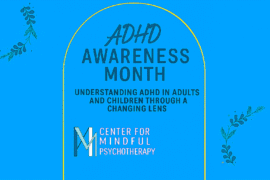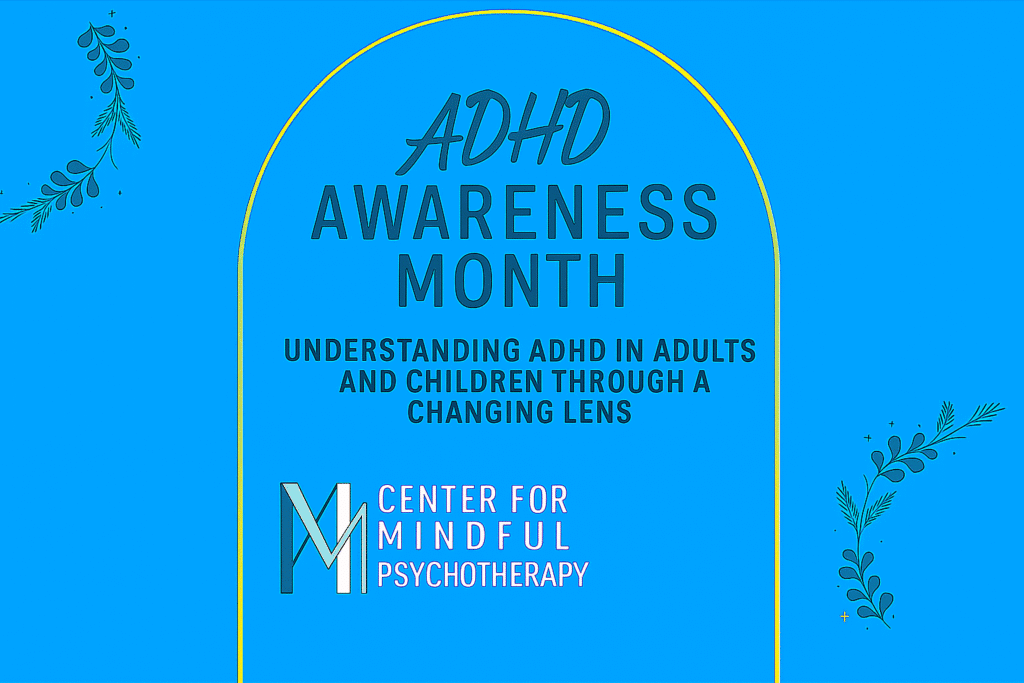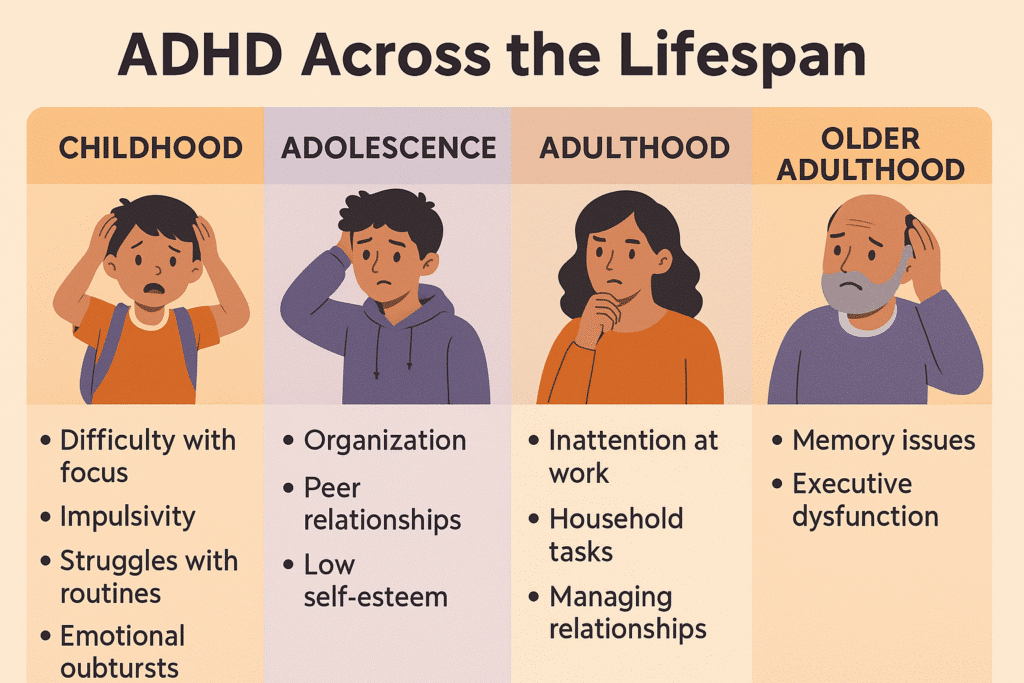

Every October, ADHD Awareness Month invites us to pause and take a closer look at what it means to live with Attention Deficit Hyperactivity Disorder across the lifespan. This is a time dedicated to raising awareness, challenging stigma, and celebrating the unique strengths that often come with a neurodivergent brain. While ADHD is frequently thought of as a childhood condition, it is a lifelong experience that continues into adulthood and beyond.
This year, the conversation around understanding ADHD in adults and children is especially important. Many children still go undiagnosed or misdiagnosed, while many adults only discover their diagnosis later in life after years of confusion or self-blame. By expanding the conversation, we not only improve recognition of symptoms but also validate the lived experience of millions of people who navigate the world with ADHD.
Browse our Therapist Directory to find an ADHD therapist today.
How Language Shapes Our Understanding
One of the most powerful ways ADHD Awareness Month drives progress is by encouraging us to reflect on the language we use. In the past, the term Attention Deficit Disorder, or ADD, was often used to describe individuals who experienced inattention without hyperactivity. Today, all presentations fall under the umbrella of ADHD, which has helped unify understanding but can still leave people confused about how symptoms show up differently.
The shift in language also reflects a broader cultural change. Terms like AuDHD, which describes people who are both autistic and ADHD, have emerged from the neurodiversity community. This newer terminology is not just a trend but a recognition of overlapping experiences that traditional diagnostic categories often overlook. By embracing evolving language, we create space for people to describe themselves in ways that feel authentic.
As therapists and educators, we see how language choices affect self-esteem and treatment engagement. When individuals hear their lived experience validated by accurate and inclusive language, they feel empowered rather than pathologized. This is why ADHD Awareness Month is not just about facts and figures. It is also about listening to the communities most affected and respecting how they choose to talk about themselves.
ADHD Across the Lifespan
ADHD does not look the same at every stage of life. For children, challenges often show up in school settings. Teachers may notice difficulty with focus, impulsivity in the classroom, or struggles with transitions. Parents may notice frequent emotional outbursts or difficulty with routines. Early recognition matters because children who receive support and accommodations are more likely to thrive academically and socially.
Adolescence brings its own challenges. Teens with ADHD may struggle with organization, peer relationships, and the growing demands of independence. These years can also bring heightened risk for low self-esteem, anxiety, or depression if ADHD is not understood in a compassionate way.
Adulthood presents another layer of complexity. Adults with ADHD often wrestle with maintaining focus in demanding jobs, keeping up with household responsibilities, or managing relationships. They may be creative and innovative thinkers, yet also feel frustrated when daily life seems harder for them than for others. Therapy can be particularly valuable here, offering strategies for emotional regulation, structure, and self-compassion. For readers who want to go deeper into this topic, our article on the role of therapy in managing adult ADHD provides insight into the practical benefits of treatment.
Older adults with ADHD face unique challenges as well. Some research suggests symptoms can shift with age, with hyperactivity less visible but memory and executive function becoming more difficult. Many older adults never received a diagnosis in childhood, so they may only begin to make sense of their lifelong struggles later in life. Our article on ADHD and aging explores this overlooked stage, showing how awareness can bring relief and new strategies even after decades of misunderstanding.
Living With ADHD in a Digital World
The digital age has brought both opportunities and obstacles for individuals with ADHD. On one hand, technology provides incredible tools for organization, reminders, and connection. Apps that support focus and time management can make a real difference. On the other hand, constant notifications, social media pressures, and the expectation of multitasking can intensify symptoms.
For children and teens, screen time can amplify impulsivity and distractibility, creating stress at home and in school. For adults, digital overwhelm can contribute to burnout and feelings of failure when attention is pulled in too many directions at once. Yet technology is not inherently harmful. With mindful use, it can actually enhance focus and support mental health. In our article about ADHD in a hyperconnected world, we take a deeper look at how individuals can strike a healthy balance with technology.
Intersectional Perspectives on ADHD
No discussion of ADHD Awareness Month is complete without acknowledging that experiences differ depending on race, gender, and cultural background. For decades, ADHD research and diagnostic criteria focused mainly on young boys. As a result, countless girls, women, and people of color were overlooked or misunderstood. This is something we especially want to focus on this year since the 2025 ADHD Awareness Month theme is “The Many Faces of ADHD.”
Today we understand that ADHD symptoms often present differently in girls, who may internalize struggles rather than display disruptive behavior. Women are frequently diagnosed much later in life, often after their own children are assessed. Cultural stigma may also prevent some families from seeking support, while systemic inequities can create barriers to diagnosis and care for marginalized communities.
These intersectional realities remind us that ADHD is not just a medical condition but also a social issue. Our article on intersectional perspectives on ADHD explores how identity shapes both challenges and opportunities for care. Similarly, our feature on Dr. Ellen Littman’s podcast highlights how women and girls with ADHD can be better supported when their unique needs are recognized.
ADHD and Relationships
ADHD does not only affect individuals. It ripples into relationships with partners, family, and friends. Forgetfulness, impulsivity, or emotional intensity can create misunderstandings and frustration. Yet relationships can thrive when both partners understand how ADHD shapes behavior and when they work together to build strategies.
Mindfulness practices, shared organizational systems, and therapy can make a powerful difference. By reducing shame and promoting clear communication, couples can shift from conflict to collaboration. In our article on navigating relationships with adult ADHD, we explore practical strategies for building healthier connections.
Celebrating Strengths Through the Lens of Neurodiversity
One of the most meaningful shifts in recent years has been the growing embrace of neurodiversity. This perspective argues that ADHD should not be understood only as a disorder but also as a natural variation of the human brain. While ADHD brings challenges, it can also bring strengths such as creativity, adaptability, and empathy.
Many people with ADHD excel at thinking outside the box, generating ideas, and pursuing passions with intensity. Hyperfocus, often seen as a challenge, can also be an asset when directed toward meaningful goals. By reframing ADHD as a difference rather than a deficit, we help reduce stigma and open up new possibilities for growth. Our article on redefining ADHD as a natural variation delves into this empowering perspective in greater detail.
Twice Exceptional: Giftedness and ADHD
Another area that deserves more attention is the experience of being twice exceptional, or 2E. This term describes individuals who are both gifted and neurodivergent. A twice exceptional child may be extraordinarily talented in areas like music, math, or writing, while also struggling with executive function, organization, or sensory challenges.
These children often confuse teachers and parents because their abilities and struggles seem contradictory. Supporting 2E individuals requires a balanced approach that nurtures their talents while also addressing their needs. Failing to recognize this combination can leave children unsupported in both directions. Our article on the twice exceptional child highlights strategies for identifying and empowering these unique learners.
The Role of Therapy and Comprehensive Care
While medication is a common treatment for ADHD, therapy plays an equally vital role. Therapeutic approaches such as Cognitive Behavioral Therapy, mindfulness practices, and skills-based interventions provide individuals with tools to manage symptoms, regulate emotions, and improve daily functioning.
Therapy can also address the emotional impact of living with ADHD, including feelings of shame, low self-esteem, or anxiety. Family therapy can help parents support children more effectively, while individual therapy can help adults reframe lifelong struggles into opportunities for growth. Our guide to contemporary ADHD care across the lifespan offers a broad overview of therapeutic options that can be adapted to each stage of life.
Building Awareness, Building Support
ADHD Awareness Month is an opportunity to reflect on progress, challenge outdated ideas, and commit to greater inclusion. By deepening our understanding of ADHD in adults and children, updating the language we use, and recognizing the diversity of experiences within the ADHD community, we take important steps toward equity and compassion.
As a therapist collective, we believe in honoring both the challenges and the strengths that come with ADHD. Whether you are seeking to understand ADHD in adulthood, learning how it intersects with technology and culture, or supporting a twice exceptional child, we invite you to explore our library of ADHD resources and to reach out for support when needed.
ADHD Support in California and the Bay Area
At the Center for Mindful Therapy, we see every day how ADHD affects the lives of children, teens, and adults across California. The Bay Area, with its fast-moving culture and high expectations, often magnifies these challenges. Many adults here are balancing demanding tech jobs, caregiving responsibilities, and personal goals, all while navigating the realities of ADHD. Families often come to us seeking support for children who are struggling in competitive academic environments, while older adults want to finally make sense of symptoms that have been present for decades.
Our clinicians offer in-person sessions at our Bay Area offices as well as secure telehealth services throughout California. This allows us to provide flexible, evidence-based care to individuals and families no matter where they are located. We believe in honoring neurodiversity, reducing stigma, and helping people identify both the strengths and challenges that come with ADHD.
If you or someone you love is seeking support, ADHD Awareness Month is a powerful time to take the first step. Reaching out for an evaluation or therapy can bring clarity, relief, and new strategies for living well. To learn more about ADHD therapy in California or to schedule a consultation, contact the Center for Mindful Therapy today.
Browse our Therapist Directory to find an ADHD therapist today.
FAQ: ADHD Therapy in California
Q: Do you provide ADHD therapy in the Bay Area?
Yes. Our licensed clinicians and associate therapists provide ADHD therapy throughout the San Francisco Bay Area, including San Francisco, Oakland, Berkeley, Palo Alto, and surrounding communities. We understand that ADHD symptoms often intersect with the unique pressures of Bay Area life, such as high-intensity academic environments and fast-paced work cultures. For those unable to visit us in person, we also provide secure telehealth sessions, making therapy accessible across the entire state of California. This flexibility ensures that children, teens, and adults can receive the care they need regardless of location.
Q: What types of therapy are available for ADHD?
Our clinicians use evidence-based approaches that have been shown to reduce ADHD symptoms and improve quality of life. Cognitive Behavioral Therapy helps clients build practical strategies for focus, time management, and emotional regulation. Mindfulness-based practices support attention control and stress reduction. Executive function coaching teaches skills like organization, planning, and prioritization. We also provide family therapy, which helps parents and children work together to create supportive home environments. Every treatment plan is individualized, and we take into account each person’s age, goals, and cultural background.
Q: Do you see adults who suspect they may have ADHD but were never diagnosed as children?
Yes. In fact, this is one of the most common reasons adults reach out to us. Many adults in the Bay Area and across California grew up during a time when ADHD was poorly understood, especially for women and people of color. As a result, they may have carried feelings of inadequacy or confusion for decades. A late diagnosis can provide powerful clarity, helping adults reframe their struggles as part of a neurological difference rather than a personal failing. We provide thorough assessments, therapy tailored to adult concerns, and tools for improving focus, organization, and self-compassion. For many clients, beginning this process feels like starting a new chapter in life.
Q: How can therapy help adults with ADHD in the workplace?
Therapy provides adults with ADHD practical tools for managing workplace challenges. Many professionals in the Bay Area work in fast-paced environments that demand organization, time management, and multitasking. Cognitive Behavioral Therapy can help adults identify unhelpful thought patterns and replace them with strategies that improve productivity. Mindfulness-based practices can reduce stress and improve focus, while executive function coaching supports organization and planning. Therapy also addresses the emotional impact of ADHD in the workplace, such as imposter syndrome or burnout, allowing adults to approach their careers with greater confidence and resilience.
Q: Do you offer ADHD therapy for families and couples?
Yes. ADHD affects more than just the individual; it impacts relationships, parenting, and family dynamics. Family therapy helps parents learn strategies to support children with ADHD while reducing conflict and stress at home. For couples, therapy can strengthen communication, reduce misunderstandings, and foster empathy when one or both partners have ADHD. At the Center for Mindful Therapy, we offer family and couples sessions in person at our Bay Area offices and online throughout California. These sessions are designed to help families and partners not only manage challenges but also recognize the strengths that come with neurodiversity.





